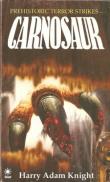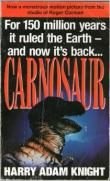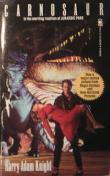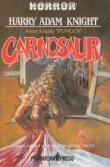AustLit
The material on this page is available to AustLit subscribers. If you are a subscriber or are from a subscribing organisation, please log in to gain full access. To explore options for subscribing to this unique teaching, research, and publishing resource for Australian culture and storytelling, please contact us or find out more.
Latest Issues
AbstractHistoryArchive Description
A scientist sets out to resurrect the dinosaurs, putting the local countryside in peril.
Adaptations
-
form
y
 Carnosaur
( dir. Adam Simon
et. al. )agent
United States of America (USA)
:
New Horizons Picture
,
1993
8676109
1993
single work
film/TV
science fiction
horror
Carnosaur
( dir. Adam Simon
et. al. )agent
United States of America (USA)
:
New Horizons Picture
,
1993
8676109
1993
single work
film/TV
science fiction
horror
A loose adaptation of John Brosnan's novel of the same name, in which a scientist wishes to infect women with a virus that will cause them to give birth to dinosaurs, bringing about the end of humanity and the return of the dinosaurs.
Publication Details of Only Known VersionEarliest 2 Known Versions of
Works about this Work
-
Reading Omens in the Escape of Genetically Engineered Dinosaurs, 1970s–1990s
2023
single work
criticism
— Appears in: Configurations , vol. 31 no. 1 2023; (p. 35-59) 'The catastrophic scenario of Jurassic Park is known worldwide and across generations, thanks to two movie trilogies, as well as countless video games, toys, and other derived products inspired by Michael Crichton's 1990 novel. Despite Jurassic Park's originality, stories of genetically engineered dinosaurs on the loose made their debut during the 1970s, when genetic technologies, such as recombinant DNA, were being developed. This article retraces, through a series of examples, the rise of a now classic narrative featuring genetically engineered dinosaurs escaping their creators, from the mid 1970s to the early 1990s. The succeeding variations around this narrative eventually forged a powerful, long-lasting cultural device processing anxieties into entertainment by fictionally predicting the consequences of genetic technologies. The deep past and dinosaurs were fashioned into a screen on which the public learned to read omens about the technological future and the end of a traditional distinction between natural and artificial.' (Publication abstract) -
The Australian Horror Novel Since 1950
2012
single work
criticism
— Appears in: Sold by the Millions : Australia's Bestsellers 2012; (p. 112-127) According to James Doig the horror genre 'was overlooked by the popular circulating libraries in Australia.' In this chapter he observes that this 'marginalization of horror reflects both the trepidation felt by the conservative library system towards 'penny dreadfuls,' and the fact that horror had limited popular appeal with the British (and Australian) reading public.' Doig concludes that there is 'no Australian author of horror novels with the same commercial cachet' as authors of fantasy or science fiction. He proposes that if Australian horror fiction wants to compete successfully 'in the long-term it needs to develop a flourishing and vibrant small press contingent prepared to nurture new talent' like the USA and UK small presses.' (Editor's foreword xii)
-
The Australian Horror Novel Since 1950
2012
single work
criticism
— Appears in: Sold by the Millions : Australia's Bestsellers 2012; (p. 112-127) According to James Doig the horror genre 'was overlooked by the popular circulating libraries in Australia.' In this chapter he observes that this 'marginalization of horror reflects both the trepidation felt by the conservative library system towards 'penny dreadfuls,' and the fact that horror had limited popular appeal with the British (and Australian) reading public.' Doig concludes that there is 'no Australian author of horror novels with the same commercial cachet' as authors of fantasy or science fiction. He proposes that if Australian horror fiction wants to compete successfully 'in the long-term it needs to develop a flourishing and vibrant small press contingent prepared to nurture new talent' like the USA and UK small presses.' (Editor's foreword xii) -
Reading Omens in the Escape of Genetically Engineered Dinosaurs, 1970s–1990s
2023
single work
criticism
— Appears in: Configurations , vol. 31 no. 1 2023; (p. 35-59) 'The catastrophic scenario of Jurassic Park is known worldwide and across generations, thanks to two movie trilogies, as well as countless video games, toys, and other derived products inspired by Michael Crichton's 1990 novel. Despite Jurassic Park's originality, stories of genetically engineered dinosaurs on the loose made their debut during the 1970s, when genetic technologies, such as recombinant DNA, were being developed. This article retraces, through a series of examples, the rise of a now classic narrative featuring genetically engineered dinosaurs escaping their creators, from the mid 1970s to the early 1990s. The succeeding variations around this narrative eventually forged a powerful, long-lasting cultural device processing anxieties into entertainment by fictionally predicting the consequences of genetic technologies. The deep past and dinosaurs were fashioned into a screen on which the public learned to read omens about the technological future and the end of a traditional distinction between natural and artificial.' (Publication abstract)
Last amended 25 Jun 2015 09:23:38
Settings:
-
cEngland,ccUnited Kingdom (UK),cWestern Europe, Europe,
Export this record






